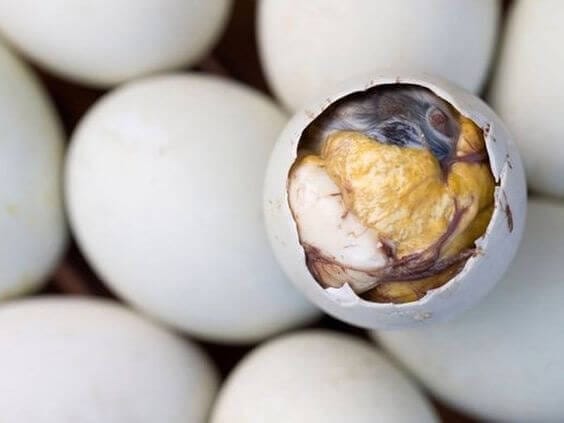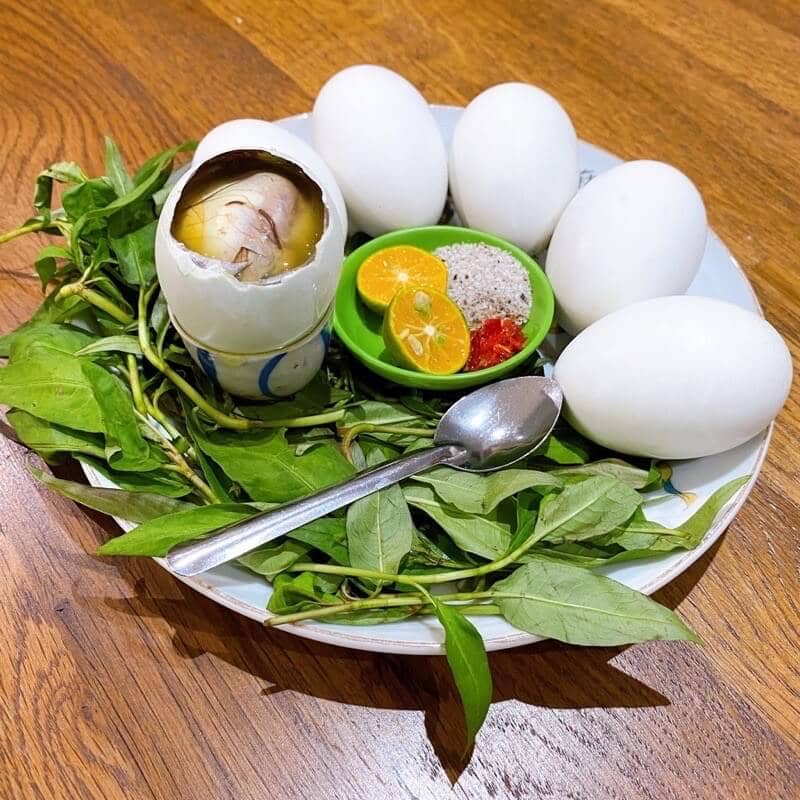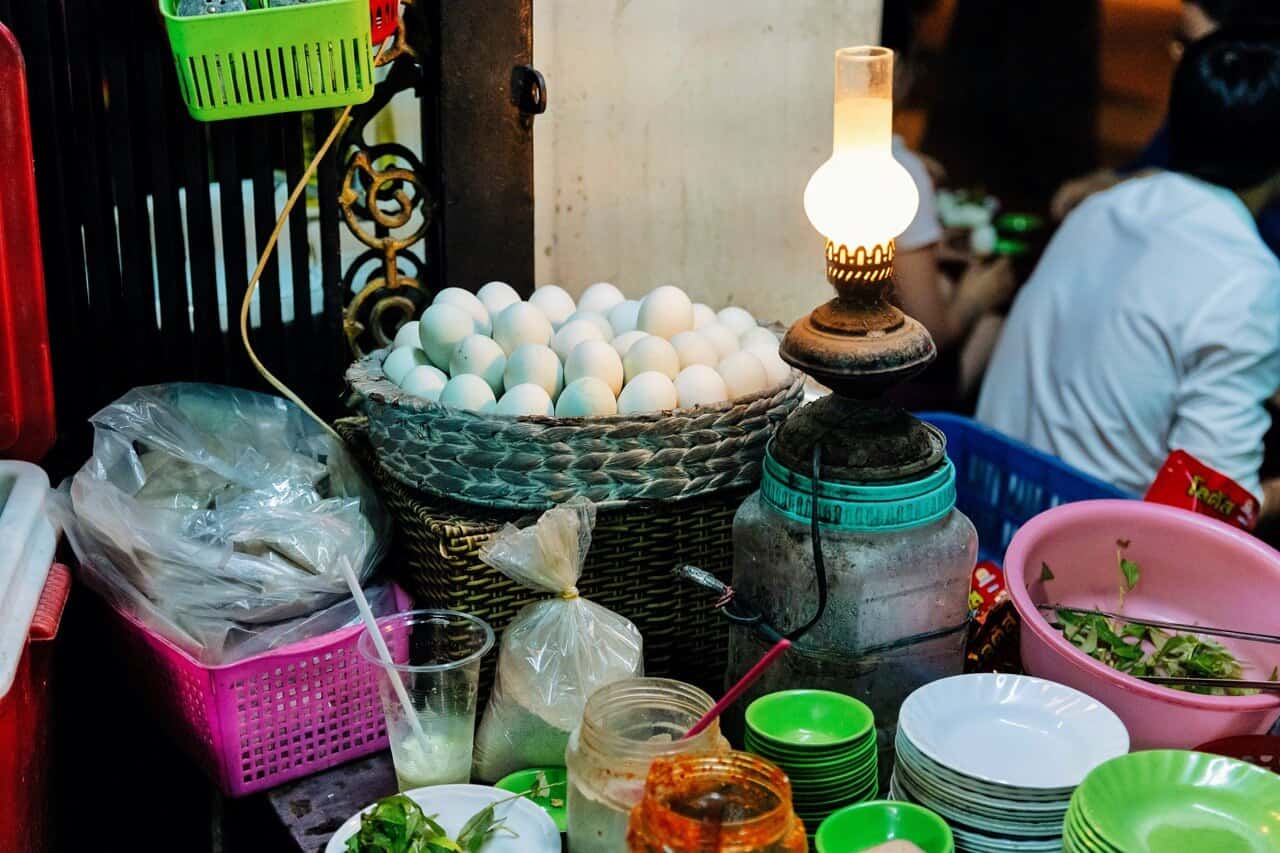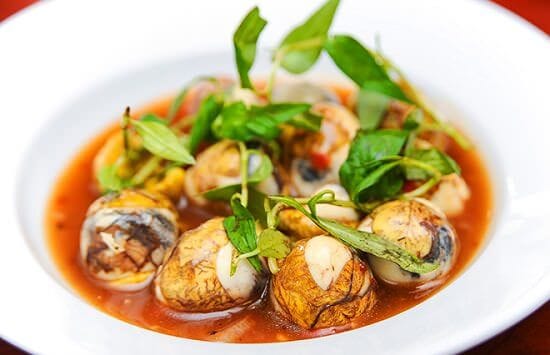In Vietnam, ‘balut’ or “trung vit lon” is a popular street food choice, celebrated for its unique flavor as well as cultural significance. This highly nutritious dish can be prepared in various delicious ways, and the way it is enjoyed often carries a symbolic meaning, such as warding off bad luck.
Discover the story behind balut Vietnam with Joy Journeys and prepare for an unforgettable culinary adventure in Vietnam!
For more information about our food tours, visit: joyjourneys.com.vn/tours/food-tour-saigon-motorbike/
Contents
What is Balut?
The Fertilized Duck Egg
Balut is a popular dish in Eastern countries, particularly in China, Cambodia, the Philippines, and Vietnam. Known as balut Vietnam, this delicacy is made from fertilized duck eggs, typically incubated for 17-21 days.

Stages of Development
Most people prefer newer, younger eggs because they are softer and easier to eat. Older eggs tend to be harder, have a stronger odor, and may even explode when boiled. The ideal eggs are around 20 days old, featuring soft egg whites and tender embryos.
Nutritional Value
A large fertilized duck egg weighs approximately 100 grams and provides about 180 calories, along with essential nutrients like protein (13,6 g), lipids (12,4 g), and calcium (82mg). Many in Eastern cultures believe that consuming fertilized duck eggs can boost nutrition, improve skin and hair health, and promote overall well-being.
How to eat balut?
Step-by-Step Guide
To enjoy balut, place the egg on a small cup, with the smaller end facing down and the larger end facing up, as the larger end contains an air gap. Use a small spoon to create a hole at the top of the egg and then scoop out the contents. While eating, you can enhance the flavor by adding a little salt and pepper or pairing it with Vietnamese coriander.

An increasingly popular variation is balut with tamarind sauce, where the eggs are served in a bowl or on a plate, drizzled with tangy tamarind sauce, and topped with peanuts and spices.
Common Accompaniments
Balut is often eaten with Vietnamese coriander, pickled radish, salt, pepper, lemon, and chili. In some regions, ginger is also a common pairing.
Etiquette and Customs
Interestingly, balut holds cultural significance in Vietnam, as some believe it can ward off bad luck. This belief stems from the Vietnamese name for the dish, which includes the word “lộn,” symbolizing change or reversal. To align with this tradition, people eat an odd number of eggs (1, 3, 5, 7, or 9) and crush the shells afterward. However, when eaten simply to satisfy cravings, an even number of eggs (2, 4, 6, or 8) is preferred.
Where to Find Balut in Vietnam?
Street Food Stalls
Balut is commonly sold at street vendors, small food stalls, or street corners. Vendors often set up on sidewalks with rows of plastic tables and chairs, making it easy for visitors to spot baskets of eggs displayed prominently on their stalls.

Local Markets
In local markets, you can find unprocessed balut at stalls that sell eggs. Just like the street vendors, these market stalls frequently offer balut as a popular item.
Restaurants
Some restaurants also serve balut, although it can be a somewhat controversial dish. To ensure availability, look for restaurants that specialize in Vietnamese cuisine and consider contacting them in advance to confirm whether they offer balut on their menu.
Overcoming the Fear Factor
Addressing Concerns
Balut is a familiar dish for Vietnamese people, but not all tourists are eager or brave enough to try it. Its appearance and unique taste can sometimes give first-timers a case of the ‘goosebumps.
Tips for First-Timers
For those hesitant to try traditional boiled balut, starting with processed variations can be a gentler introduction. Options like stir-fried balut with tamarind or balut hotpot can help tone down the characteristic taste. Alternatively, quail balut eggs, with their smaller size and milder flavor, might be an easier first step for adventurous eaters.

Embracing the Adventure
Vietnamese cuisine offers countless delicious and intriguing dishes, but stepping out of one’s comfort zone is key to fully enjoying these culinary experiences. Moreover, dishes like crab paste vermicelli soup or noodle and tofu with shrimp sauce boast distinctive flavors that are truly worth trying.
Conclusion
Your journey to explore Vietnam becomes even more exciting when you embrace new and unique flavors. Balut Vietnam is one dish worth considering during your visit, offering a distinctive and memorable culinary experience. Don’t miss the chance to make this an unforgettable part of your adventure!


Related Posts
Food Market Ho Chi Minh: Where To Eat Like A Local
Explore the flavors of Vietnam at every food market Ho Chi Minh has to offer! From the iconic Ben Thanh Market to lesser-known local spots, these bustling hubs are where street food, culture, and community come together. Start your culinary journey in the heart of the city today. Contents1 Why Explore Food Market Ho Chi […]
Night Market Ho Chi Minh City: A Shopper’s & Foodie’s Guide
Discover the best night markets in Ho Chi Minh City! From Ben Thanh’s buzz to Ho Thi Ky’s flowers & food, find top spots for shopping, street food, and local culture. Experience the vibrant energy of night market Ho Chi Minh scenes, where the city truly comes alive after dark. From the iconic Ben Thanh […]
Ho Thi Ky Flower Market: A Blooming Paradise in Saigon
Ho Thi Ky Flower Market is one of the most colorful and enchanting Saigon attractions you won’t want to miss. Whether you’re a photographer, culture lover, or simply seeking a refreshing escape from the city buzz, this market offers a truly immersive local experience. Open 24/7 and busiest in the early morning hours, it’s not […]